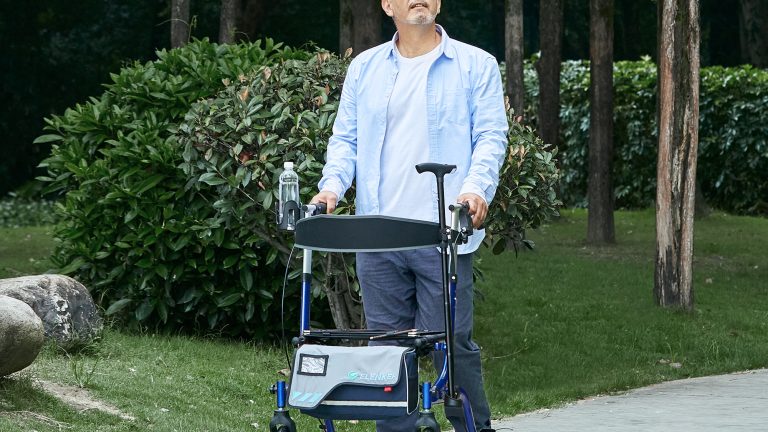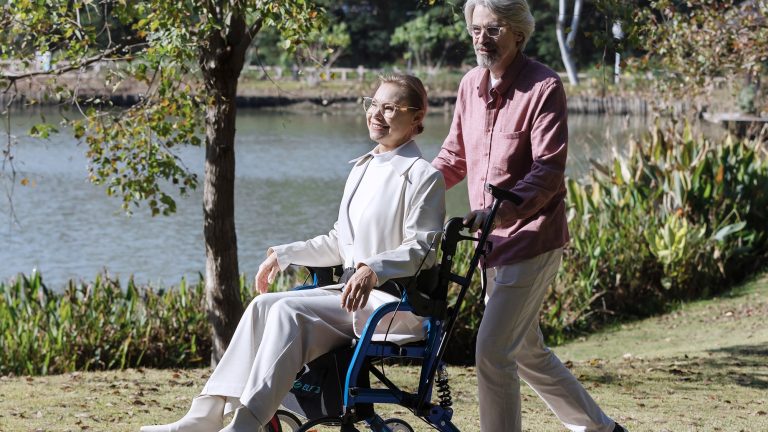When it comes to mobility aids, choosing the right walker can make a huge difference in how comfortably and safely you move around. The two most popular options are the 3-wheel walker and the 4-wheel walker. While both are designed to assist with walking, they have distinct differences that may make one more suitable than the other based on your lifestyle, needs, and preferences. Let’s dive into the key differences between these two types of walkers with wheels, including their design, stability, maneuverability, and features like walkers with seats.
1. Design and Structure: Three vs. Four Wheels
The primary difference between a 3-wheel walker and a 4-wheel walker is, of course, the number of wheels.
- 3-Wheel Walker: This type has three wheels – one in the front and two in the back. It has a lightweight, more compact design, making it ideal for those who need a portable and easy-to-maneuver walker for indoor use. The 3-wheel walker is often more narrow, which makes it easier to navigate through tight spaces like hallways or store aisles.
- 4-Wheel Walker: As the name suggests, this walker has four wheels, providing a more stable structure. It usually has two wheels in the front and two in the back, and it can be equipped with walkers with seats for added comfort. A 4-wheel walker, often referred to as a rollator walker, tends to be larger and more durable, offering greater stability for people who need extra support while walking or standing.
2. Stability and Support
When it comes to stability, 4-wheel walkers generally have the advantage. With four wheels, they provide better support and balance, making them a safer choice for people who need more stability when walking. The additional back wheels make it harder for the walker to tip over, which is especially helpful when walking on uneven surfaces or when needing to stop quickly.
- 3-Wheel Walker: While 3-wheel walkers are lightweight and easy to maneuver, they don’t provide the same level of stability as a 4-wheel walker. The lack of a rear wheel makes it more prone to tipping, especially if you’re walking on sloped surfaces or uneven terrain. These walkers are better suited for flat, smooth surfaces like indoor floors or paved sidewalks.
- 4-Wheel Walker: The four-wheel design, along with the wider base of support, makes 4-wheel walkers much more stable, especially when walking on slightly uneven surfaces. They’re a great option if you plan to use the walker both indoors and outdoors or if you need to walk longer distances.
3. Maneuverability
Maneuverability is another area where 3-wheel walkers and 4-wheel walkers differ. A 3-wheel walker is often more agile, making it easier to turn corners, navigate through tight spaces, and store when not in use. If you only need a walker for shorter distances and smooth surfaces, a 3-wheel walker may be the more convenient option. It’s also lightweight, so you can carry it with ease, especially when folding it down for storage or travel.
- 3-Wheel Walker: Due to its compact design, the 3-wheel walker is generally easier to maneuver in smaller spaces. You can turn corners or navigate around obstacles with less effort. This makes it ideal for indoor use in smaller homes or apartments where space might be limited.
- 4-Wheel Walker: A 4-wheel walker can also maneuver well, especially with large wheels that glide easily across smooth surfaces. However, because of its larger size and additional wheels, it may not be as easy to maneuver in cramped spaces or tight areas compared to a 3-wheel walker. On the plus side, many 4-wheel walkers come with ergonomic handles, making them easier to control for people who need a more steady walk.
4. Walkers with Seats: Comfort and Resting
One of the most notable differences between a 3-wheel walker and a 4-wheel walker is the option for a seat. Many 4-wheel walkers are equipped with a built-in seat, which is perfect for people who need to rest during longer walks or outings. This makes them ideal for individuals who tire easily or have limited stamina.
- 3-Wheel Walker: While some 3-wheel walkers do have a small seat, these are often smaller and less comfortable than the seats found on 4-wheel walkers. The focus of the 3-wheel walker is more on mobility and compactness than providing a place to sit for an extended period.
- 4-Wheel Walker: 4-wheel walkers, especially rollator walkers, often come with padded seats, making them a great option for people who need to take breaks while walking. These walkers with seats typically have a large, comfortable seat that can support longer periods of rest. The added seat is an excellent feature for people who find themselves needing to stop frequently during walks.
5. Outdoor Use
If you plan to use your walker outdoors, 4-wheel walkers are generally the better choice due to their stability and larger wheels. They can handle more varied terrains, such as grass, gravel, or slightly uneven paths, with greater ease.
- 3-Wheel Walker: A 3-wheel walker is typically best suited for smooth, flat surfaces. While it may work well on a sidewalk or indoors, it may struggle on uneven surfaces or rough terrain. If you’re looking for a walker for outdoor adventures, a 4-wheel walker would be a better option.
- 4-Wheel Walker: With larger wheels and a sturdy frame, 4-wheel walkers are better equipped to handle a variety of outdoor surfaces. Whether you’re walking on a sidewalk, park path, or paved trail, a 4-wheel walker provides more stability and comfort for longer outdoor walks.
6. Portability and Storage
In terms of portability and storage, the 3-wheel walker is more compact and lightweight, which makes it easier to fold and store. It’s an excellent option for people who want a walker that’s easy to carry and doesn’t take up too much space.
- 3-Wheel Walker: Since it’s smaller and lighter, a 3-wheel walker is much easier to transport. You can fold it up in seconds and fit it into the trunk of your car or store it in a closet without taking up much room.
- 4-Wheel Walker: While 4-wheel walkers are larger, many models are designed to fold up for easier storage. However, they may be bulkier and heavier than a 3-wheel walker, which could make them more challenging to transport if you need to take it with you in a car.
Which Walker is Right for You?
Both the 3-wheel walker and the 4-wheel walker have their advantages, so choosing the right one depends on your specific needs.
- If you need something lightweight, compact, and easy to maneuver in small spaces, the 3-wheel walker could be the right choice, especially if you mostly plan to use it indoors or on smooth paths. It’s an excellent option for people who need something portable for short walks or errands.
- On the other hand, if you need more stability, comfort, and the option to rest while walking, a 4-wheel walker may be the better fit. With its larger wheels, walkers with seats, and improved support, it’s ideal for outdoor use and longer walks.
Ultimately, both types of walkers with wheels can improve your mobility, but considering factors like where you’ll be using it, how often you’ll need to rest, and whether you require more stability will help you make the best decision for your lifestyle.

